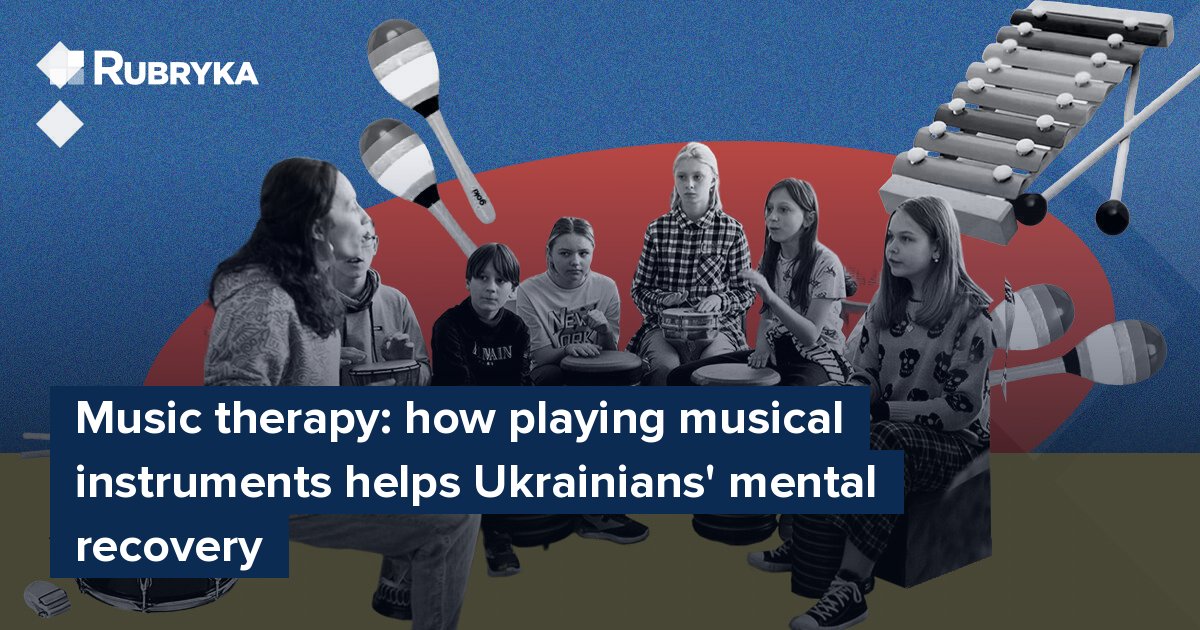
What is the problems?
During the war, various stressful conditions have become constant companions of Ukrainians, especially among children and displaced persons. Those who were forced to leave their homes due to a full-scale invasion are haunted by feelings of anxiety and uncertainty. The difficulties of adaptation are physically and psychologically exhausting, and conflicts with loved ones and family members are not uncommon. Children, especially those having to learn online in recent years, often lose their communication skills and have difficulty interacting with their peers.
What is the solution?
Music therapy can help find a way to inner balance. Psychologists say that it is the most careful tool in working with the human psyche, which allows you to reveal deep experiences and often gives an impressive result. For those who desire to "reboot" thanks to new, unusual experiences, want to learn to express their emotions and are ready to move along the path of self-discovery, enthusiasts and specialists are currently organizing special music classes in various cities of Ukraine. Singing and playing music on simple instruments can help people cope with stress, voice what is difficult to talk about, and believe in themselves and their potential.
How does it work?
"You need to appreciate every moment of your life"
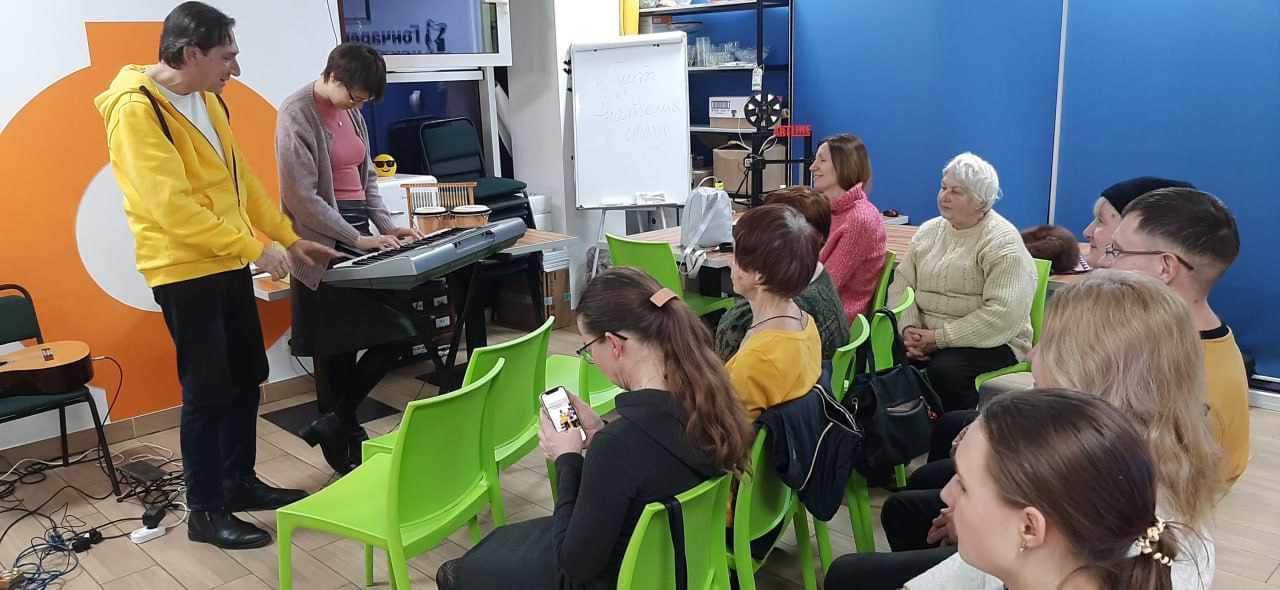
In Kropyvnytskyi, professional musician Volodymyr Lobach conducts music classes that help people cope with stress.
This is exactly the philosophy of the Anatomy of the Elements music group, headed by Volodymyr Lobach, a professional musician and guitar teacher at a local music school. Since the beginning of 2024, he has been conducting music classes to help people cope with the challenges of war.
Lobach's idea arose from his practical experience. While working as a teacher in a music school, he noticed that children are happy to learn musical instruments, touch strings or keys, and listen to the sound with satisfaction. He decided to organize this process by creating various rhythmic games on notes to the accompaniment, which interests both children and their parents.
Lobach began to develop a method of creating music for those who do not know how to play instruments and to support concert participants of the Anatomy of the Elements band in the joint creation of music right on stage with professional musicians.
"It wasn't music therapy yet, but more like a game. Such an idea had considerable success. People tried to play simple musical instruments, sang, and created melodies for songs with us. It was entertaining and interesting, and most importantly — easy. You only needed to have the desire for this," recalls Lobach.
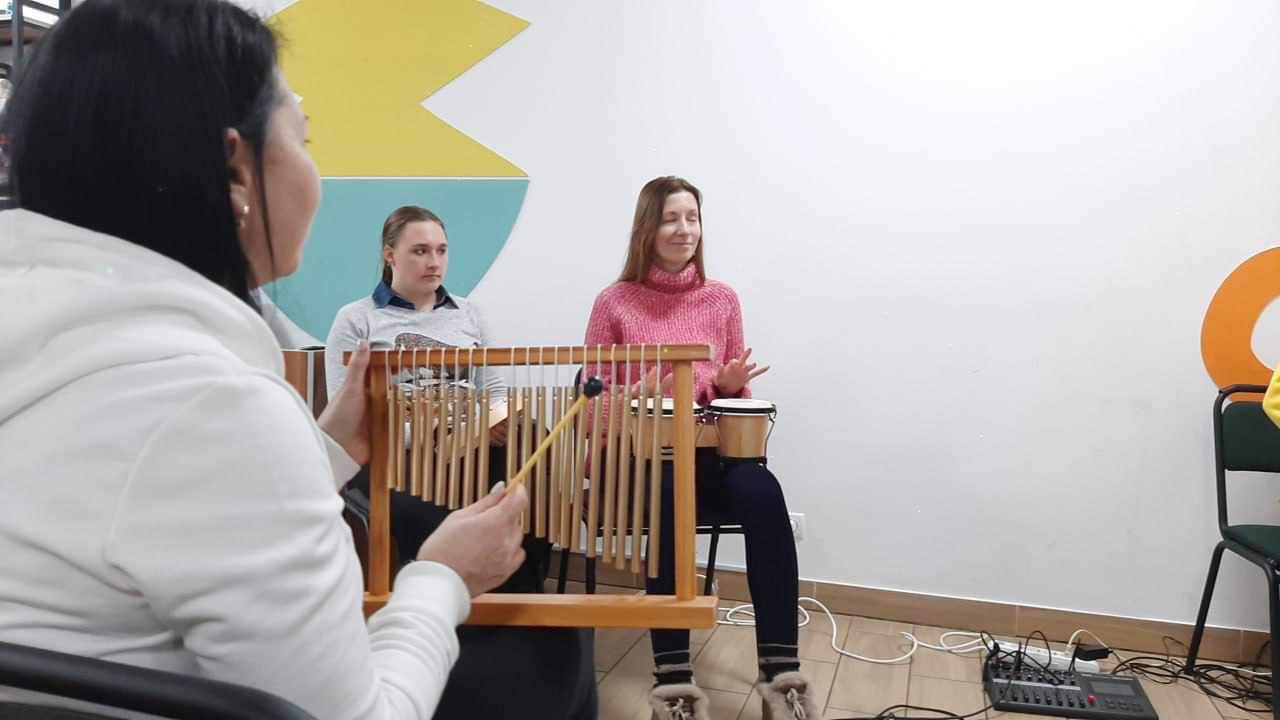
Making music in Kropyvnytskyi.
Music classes for adults, which no longer just interested people but also, according to feedback, helped to restore their mental health, the musician began to conduct already during the war, in 2023. Later, the Anatomy of the Elements team was offered a room for classes by the educational and cultural space Honcharenko Center Kropyvnytskyi. Now, once every two weeks, music therapy events take place there free of charge.
Music therapy classes consist of two parts. The first is passive, when listeners listen to calm, harmonious music musicians perform and adjust to a creative mood. The second is active when they independently play various musical instruments — guitar, ukulele, synthesizer, and various noise and percussion instruments. At first, people are usually shy, but eventually, the magic of music begins to work, and even those who have never picked up a musical instrument dare to play.
"We create music, compose songs based on our favorite poems, improvise collectively. At the end, we all sing Ukrainian songs together. The whole event occurs on a cheerful, positive, harmonious wave," says Lobach.
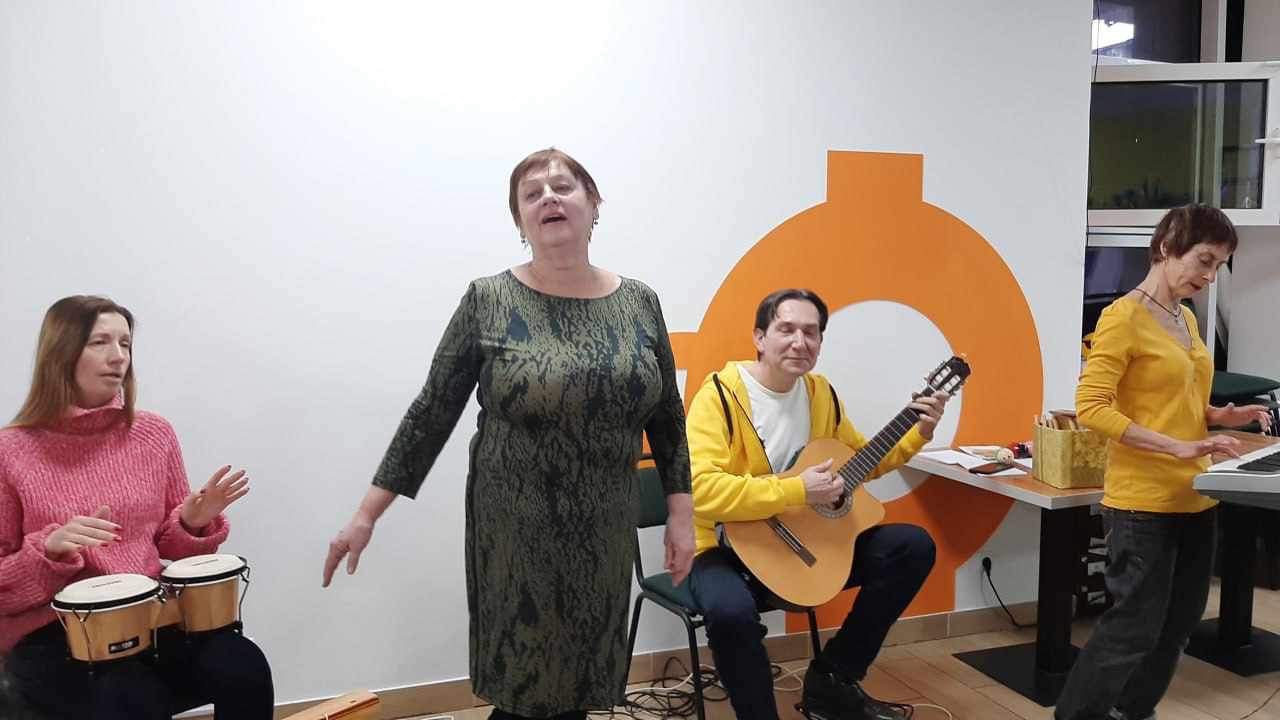 During music therapy classes, a person can try themself as a soloist or ensemble artist.
During music therapy classes, a person can try themself as a soloist or ensemble artist.
According to the teacher, such classes greatly benefit the participants, as they reveal a person's creative potential, which positively affects the psycho-emotional state. They also develop creativity and imagination to help cope with stress and strengthen the nervous system. During music therapy classes, a person can feel like a soloist or an ensemble artist.
In a playful way, a person acquires the initial skills of public speaking and, thanks to this, gets rid of the shyness complex. While practicing, a person trains the freedom to simply be themself.
"The language of music is accessible to every person"
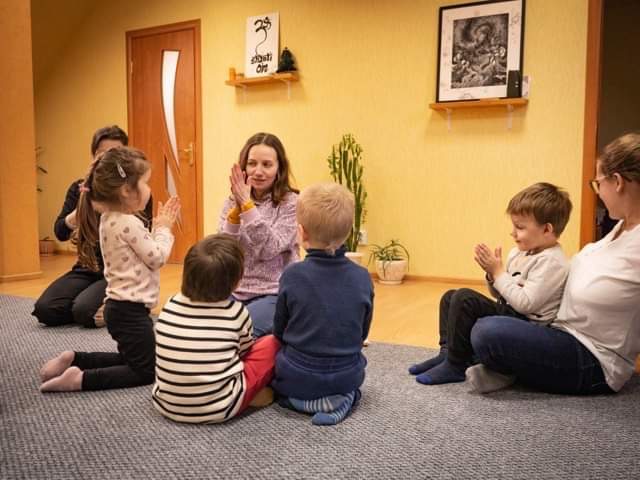
Children during a class, Uzhhorod.
In Uzhhorod, music therapy classes for children and adults are conducted by Kateryna Kudasheva, a facilitator of music extracurriculars, a musicologist and music teacher, and the founder of the NGO Sol Diez, which aims to spread the culture of collective music making.
Kudasheva also started music lessons for preschoolers and older children. She says such classes revealed the child's potential more than trying to teach them something. In the last year, the music teacher expanded her activities thanks to the financing of the International humanitarian organization "People in Need, Slovak Republic." The project managed to buy more musical instruments, recruit many groups, and start visiting schools, hospitals, boarding schools, and shelters for IDPs.
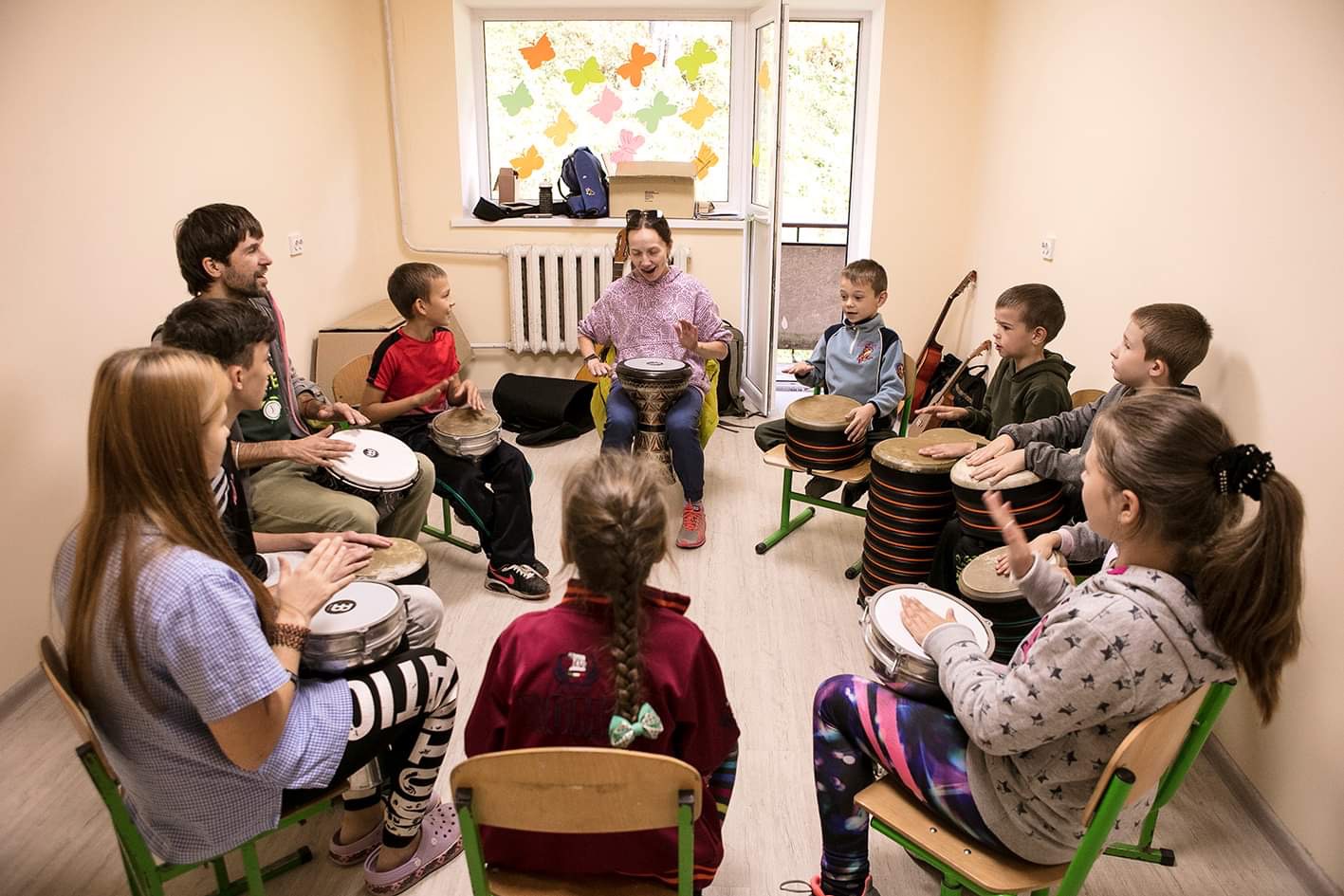
The village of Nizhniy Bystryi, a musical class for residents of a dormitory for internally displaced persons. Photo: "People in Need, Slovak Republic"
"I realized that people, children, and adults do not need to learn something specific — they rather need to express something of their own, certain accumulated emotions, with the help of music," says Kudasheva. The teacher doesn't like calling such classes music therapy because, in most cases, therapy is the treatment of something. The team works with patients suffering from Parkinson's disease, and in this case, music therapy is part of rehabilitation. In other cases, people who come to classes do not express a request for treatment; they just need to relieve stress and talk. It would be correct to call it psychosocial support classes with a therapeutic effect.
The Sol Diez studio specialists mainly organize musical classes for children and teenagers, but it was also noticed that their parents are also interested in such activities.
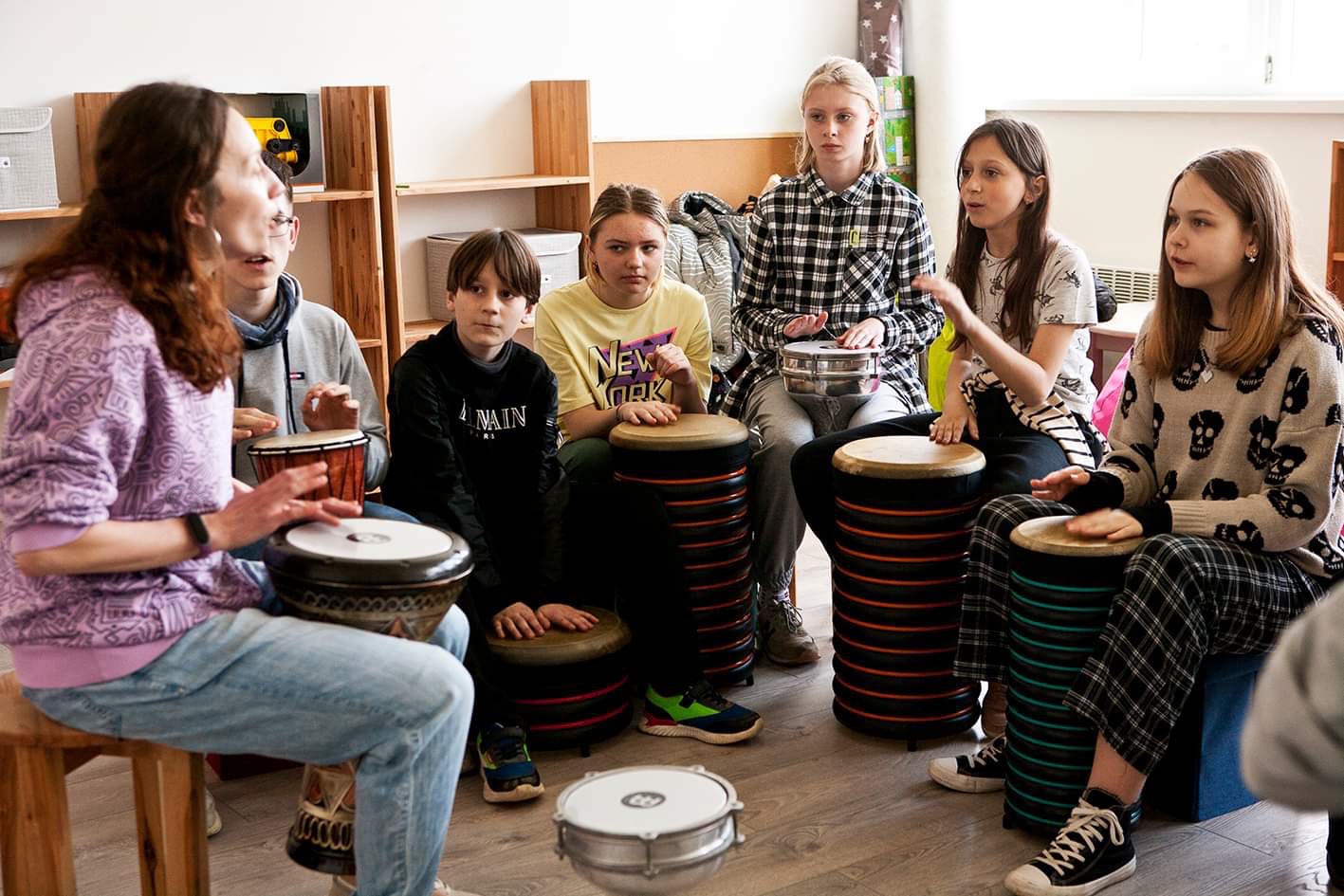
A musical class for local children aged nine to 14. Photo: "People in Need, Slovak Republic"
Many shy Ukrainian children spend days on their phones — they study online for the first half of the day and chat in the afternoon. Children have forgotten how to communicate with each other live. Music helps a lot here, as classes give children a safe territory to restore communication skills through music.
According to the teacher's observations, music can allow adults to express something special, significant, and personal. With non-verbal methods, music helps people reduce their level of anxiety and can be helpful in panic moods and the fight against fears. It also helps to increase self-esteem because, in classes, a person does something they have never done before and succeeds.
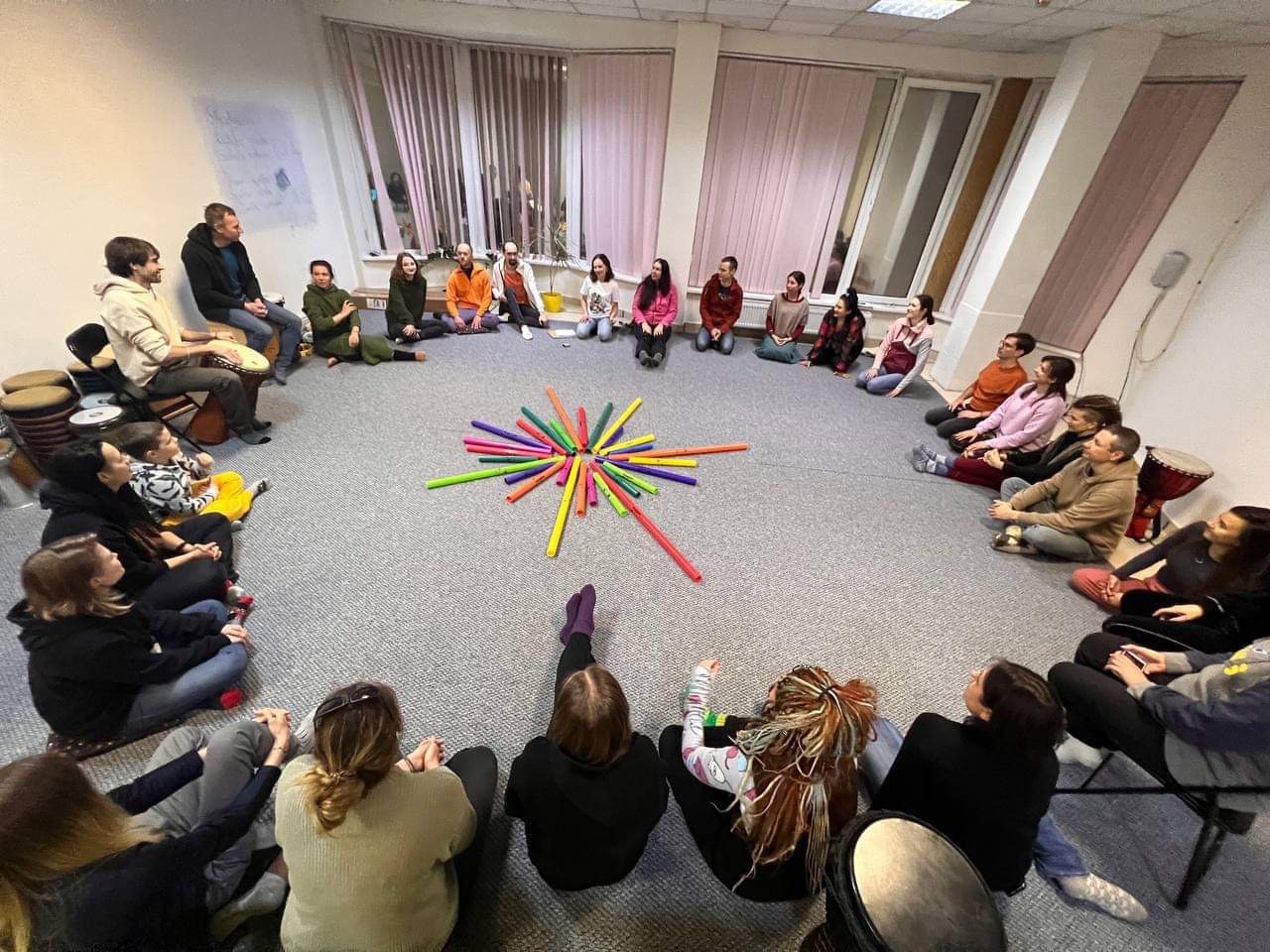
Musical circle for adults, Uzhhorod.
"Usually, we sit in a circle to see each other, to feel united. We have many exercises to enter this circle psychologically. To understand that you are accepted here is very important," says Kudasheva. The teacher uses many techniques in classes. It can be simply the reproduction of certain rhythms or songs. There may be a composition if the group has worked together for a long time. They also create musical theater performances and improvise — develop a topic that the group itself sets. In the end, they must have a ritual of soft exit from this circle — do everything to make each participant feel comfortable during and after the entire class.
The teacher says that people often write songs about love, hope, the power of goodness, abandoned hometowns, and the return of loved ones home from the war. Among the instruments, both children and adults like drums the most. In Sol Diez, many of those are not played with sticks, as on percussion instruments; instead, there are various types of djembes, darbukas, and cajones, which must be played simply with the hands.
Drums provide an opportunity to express some negative feelings, such as aggression. "We had such cases when children drummed for a whole hour so that their hands hurt, and it was impossible to stop them or switch to something else," Kudasheva continues. "I am also sure that it is a good tool for reducing stress. Something in the drums allows people to let out everything accumulated, depressed."
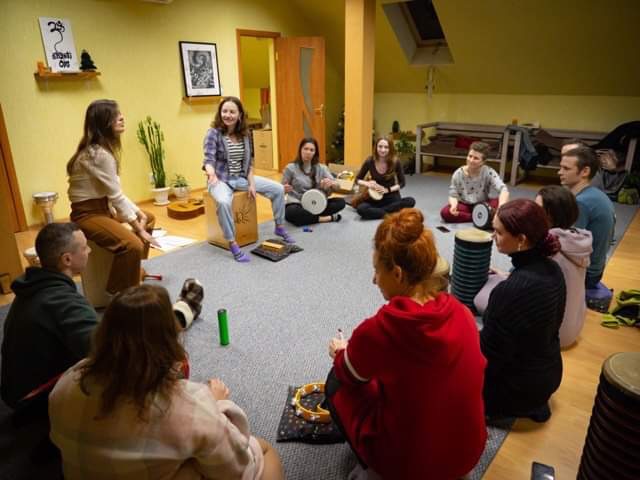
Music circle for adults in Uzhhorod.
Besides drums, other instruments are also very popular— idiophones, glucophones, petal drums, xylophones, metallophones, and hanging triangles. There are also boomwalkers — light, hollow plastic tubes tuned to musical pitch in length. All these tools are very simple, mix well, and do not require prior experience. They will sound harmonious, even if one participant improvises one thing and their neighbor does something completely different.
Not every member of the music circle stays in the group after the first class, and this is normal, says Kudasheva. However, those who like this self-expression and stress relief method return to the studio repeatedly.
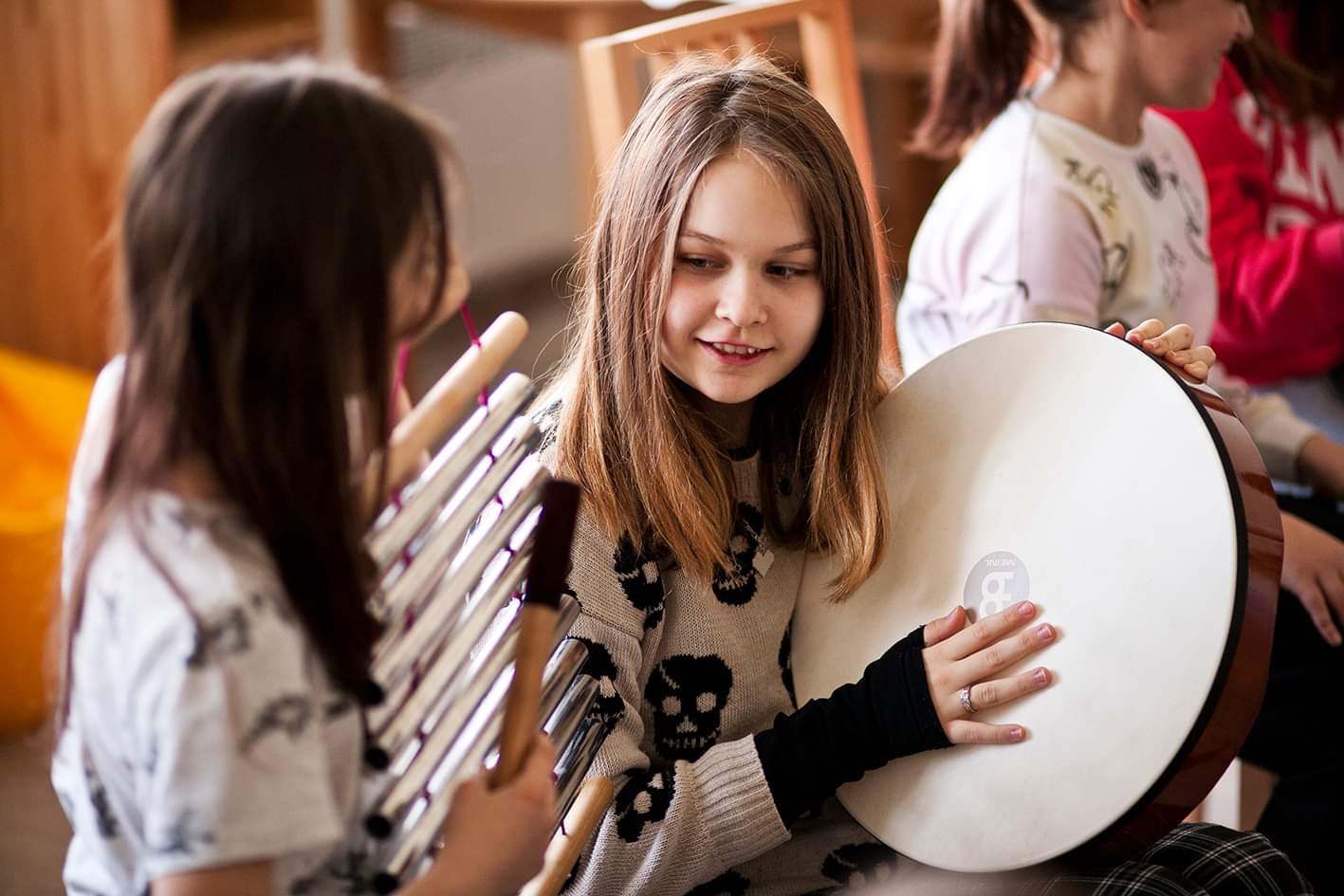
Participants of the musical circle in the village of Velykyi Bereznyi. Photo: "People in Need, Slovak Republic"
The language of music is accessible to every person. With the help of music, people can express different emotional states or the quality of certain things that are very difficult to express in words. Kudashova is sure that it does not happen that a person does not have a sense of rhythm. If a person walks, they already have a sense of rhythm. "Each of us has a heart that beats in a certain rhythm. In the same way, each of us can speak in different intonations, which is also music. There is no need to be afraid to play music. You don't need an entire orchestra for this. The main thing is that you have something to say," says Kudasheva.
Does it really work?
"Self-care through music"
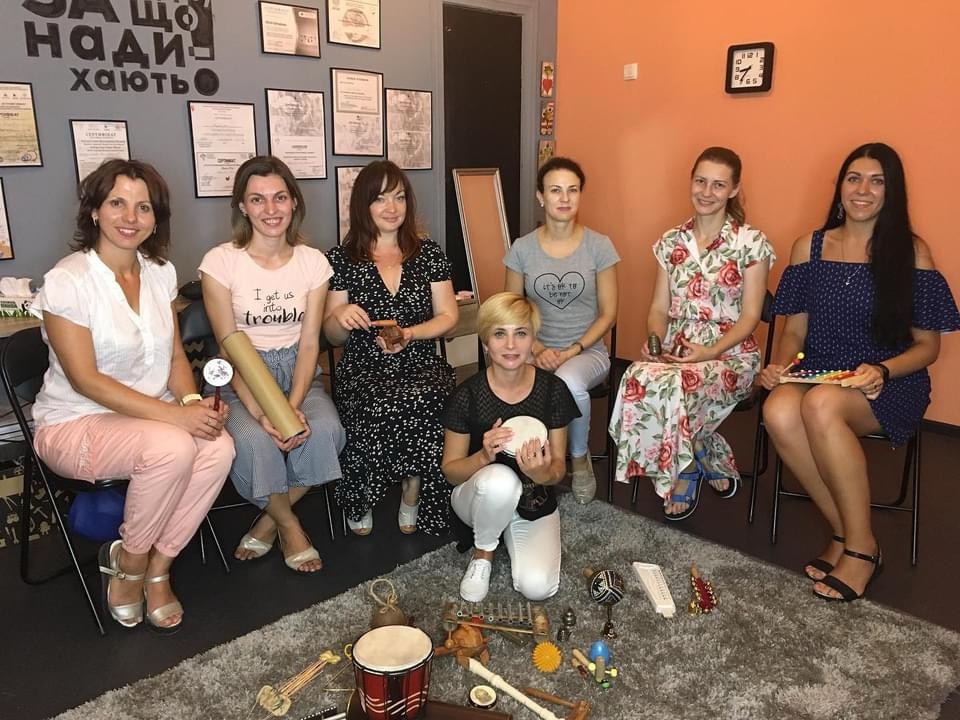
Yuliia Shnurova with participants in music therapy classes in Khmelnytskyi.
In Ukraine, music therapy is just beginning its professional development. At the same time, in many countries in Western Europe and the USA, many music-psychotherapy centers, associations, organizations, and training programs train specialists in this direction. For example, about 3,500 professional music therapists are registered in the United States. Also, in most of these countries, music therapy is included in health insurance packages and is available to many people.
The attitude towards music therapy is gradually changing in Ukraine as well, and professional music therapists also appeared. One of them is Yuliia Shnurova, a psychologist, certified music therapist, and member of the Association of Music Therapists of Ukraine, which unites specialists from different parts of Ukraine and is a member of the European Confederation of Music Therapy. Shnurova started using music therapy techniques in her psychological practice more than six years ago. Since 2019, she has been organizing and leading music therapy groups in Khmelnytskyi. She speaks at seminars and master classes and shares her practical experience with colleagues and everyone interested in music therapy.
Music therapy is a soft and ecological method of psychological work in which a person can express the strongest emotions, discuss the most frightening topics, and be heard and accepted, using a minimum of words and a maximum of sounds. The literal translation of the term "music therapy" is of Greek-Latin origin and means "musical treatment." However, the etymology of the word therapy has another interpretation — it is "service" or "care." "I like this interpretation more. Music therapy is like taking care of a person's soul with the help of music," says Shnurova.
Music therapy is used in various institutions: rehabilitation centers, psychiatric hospitals, maternity homes, palliative care centers, educational institutions of various levels, and social institutions. Music therapy shows significant success in correcting many psycho-emotional conditions, including mental disorders of various spectrums, neurological problems, and psychosomatic manifestations, and also helps relieve pain, reduce stress and anxiety, process traumatic experiences, and overcome the consequences of PTSD.
Music therapy covers such a wide range of problems because music has its own special universal language: emotional saturation, internationality, abstraction, associativeness, and symbolism. This language is understandable to everyone. Music affects a person on all levels: physical, emotional, mental, social, and cognitive. It is perceived not only by hearing but also by all body analyzers and systems. Under the influence of music, chemical reactions are rearranged, blood pressure, heart rate, rhythm, and depth of breathing change, and the status and characteristics of both physiological and mental states change.
For example, neurophysiologists claim that our brain perceives music simultaneously with both hemispheres. This allows people to create new complex neural connections and stimulate the brain. Scientists have concluded that music activates reward centers in the brain and suppresses the release of stress hormones. This allows you to release and process negative feelings such as anger, guilt, shame, fear, and anxiety, which are often blocked in the psyche. When playing a musical instrument, almost all brain areas are activated. Listening to your favorite music, in turn, stimulates activity in those parts of the brain that are associated with processing social information and promoting empathy development. With its indirect, non-verbal nature, music acts as a powerful stimulator of communication and integration.
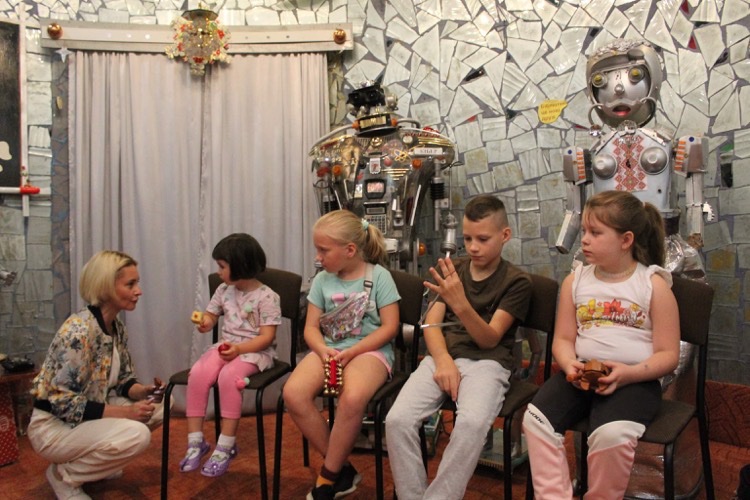
Group format of music therapy meeting for children.
Therefore, music therapy is also actively used when working with children with autistic spectrum disorder, ADHD, as an element of the rehabilitation of people after a stroke, with patients with epilepsy, and with military personnel who have suffered concussions or suffer from post-traumatic stress disorder. The main purpose of using music during such therapeutic meetings is for the client to achieve the effect of "catharsis," i.e., psycho-emotional cleansing and emotional release — the living of emotions and feelings and somatic states, body sensations.
Shnurova adds that in music therapy, a person does not need to worry about whether they know how to play or sing. Experience in making music — playing musical instruments or possessing any special vocal data or musical talents — is unnecessary. The main thing is the experiences, emotions, and thoughts you want to express through musical sounds.
Even more useful solutions!
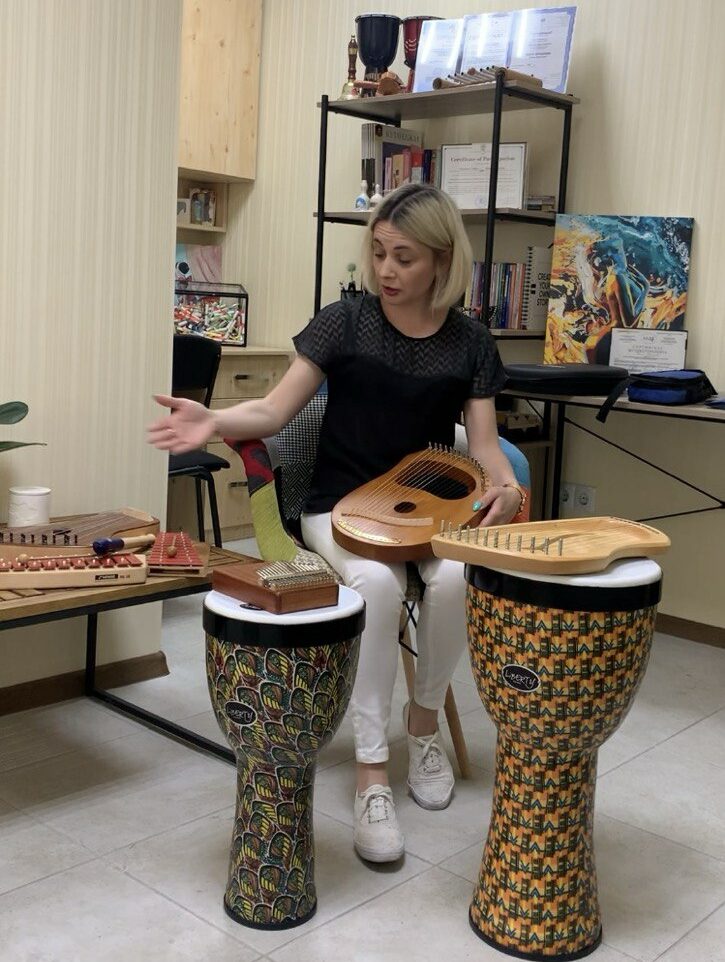
Yuliia Shnurova, a music therapist and psychologist, demonstrates the possibilities of simple musical instruments.
A person who cannot attend music therapy sessions can make their own musical first aid kit. Rubryka asked a music therapist how to do it correctly.
The most important thing is that you like the music, says Shnurova. However, the main criterion when choosing musical pieces for, for example, musical relaxation is their calming effect. For passive music therapy, the psychologist recommends the following classic works:
- V.Mozart, Sonata for piano, II movement, F major (Adagio),
- J. Bach, "Branderbuzky concerto" No. 1, F major (Adagio),
- Zh. Masne, "Thought",
- I. Strauss, "Slow Waltz,"
- F.Schubert, "Evening Serenade",
- A. Vivaldi, Concerto for Flute and Orchestra No. 4,
- J.Masnet, "Elegy",
- Rondò Veneziano "Crepuscolo",
- Sounds of nature.
Active music therapy means that a person participates in making music, not just listening to music. This type of therapy uses vocal therapy (singing) and playing various musical instruments. It is important to note that vocal therapy can be especially useful for treating chronic diseases of the lungs, bronchi, heart, and blood vessels, as well as for improving immunity and correcting diction defects and stuttering.
Vocal therapy also has a psychotherapeutic effect when singing lullabies, folk tunes, or any vocal compositions that reflect your emotional states. It can help you express and process emotions, reduce stress, and improve mental well-being.
"The voice is the musical instrument that we mastered from the first seconds of our birth, and we can always use it. Having special vocal data is unnecessary — you can simply hum or softly sing along. The main thing is to voice and declare yourself," advises Shnurova.
Instrumental improvisation on simple musical instruments allows people to play what they cannot say. The main value of this therapy is that everyone in it can feel like a creator and independently manage the process of their own play. This helps to strengthen faith in one's own strengths and capabilities and develops communication, on the one hand, and self-reflection, on the other.
Do you have a desire to improvise, but you don't have any musical instruments at hand? Look around. You will definitely find an item that can make a sound. It can be a bunch of keys, a plastic bottle, a sheet of paper, crystal glasses filled with water, or a box of rice wrapped in foil that can be turned into homemade maracas.
Human body is also a universal musical instrument. Clapping your hands, snapping your fingers, stomping your feet with varying degrees of force, patting your knees or hips — and you are already engaged in body percussion. It also has benefits because these actions allow you to eliminate negative emotions, neurotic disturbances, fears, and emotional blocks.
An interesting form of active music therapy is the combination of the psychotherapeutic influence of music with other types of art: drawing to music, pantomime, dance improvisation, or storytelling techniques.
Newsletter
Digest of the most interesting news: just about the main thing



